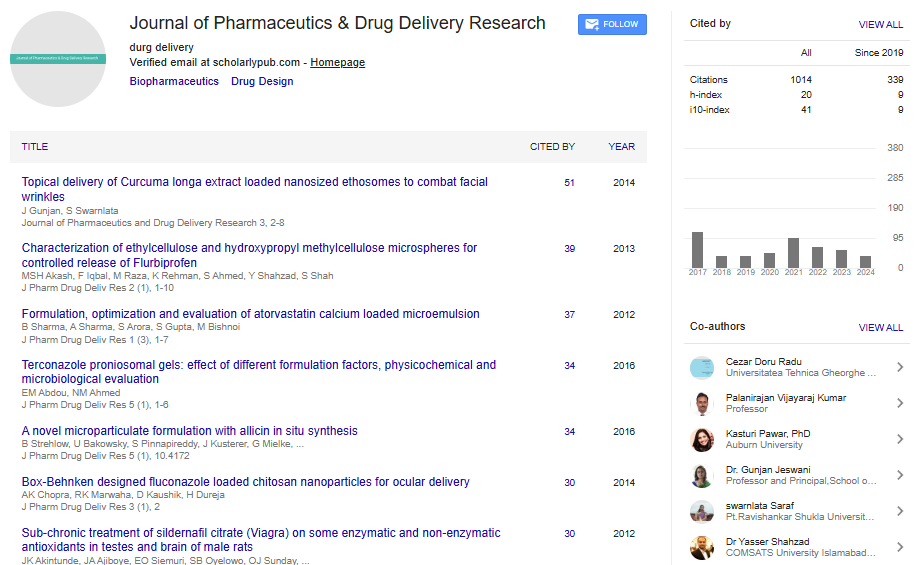Commentary, J Pharm Drug Deliv Res Vol: 13 Issue: 4
Pharmacovigilance's Significant Role in Maintaining Drug Quality
Wenlei Jiang*
1Department of Pharmacology, University of Burgundy, Dijon, France
*Corresponding Author: Wenlei Jiang,
Department of Pharmacology, University
of Burgundy, Dijon, France
E-mail: jiangw39@gmail.com
Received date: 01 July, 2024, Manuscript No. JPDDR-24-145761;
Editor assigned date: 03 July, 2024, PreQC No. JPDDR-24-145761 (PQ);
Reviewed date: 17 July, 2024, QC No. JPDDR-24-145761;
Revised date: 24 July, 2024, Manuscript No. JPDDR-24-145761 (R);
Published date: 31 July, 2024, DOI: 10.4172/2325-9604.1000290
Citation: Jiang W (2024) Pharmacovigilance's Significant Role in Maintaining Drug Quality. J Pharm Drug Deliv Res 13:4.
Description
Pharmacovigilance is a precarious component of healthcare that focuses on the detection, assessment, understanding and prevention of adverse effects or any other drug-related problems. Its primary objective is to ensure that medicines on the market are safe and effective for patients. With the increasing complexity of drug therapies and the rapid pace of pharmaceutical development, pharmacovigilance has become more essential than ever in safeguarding public health.
The concept of pharmacovigilance has evolved significantly since its inception. Historically, Adverse Drug Reactions (ADRs) were often overlooked or underreported, leading to significant public health crises. One of the most notorious examples is the thalidomide disaster in the 1960s, where the drug, initially prescribed as a sedative, caused severe birth defects in thousands of babies worldwide. This tragedy underscored the need for more rigorous monitoring of drugs once they are on the market.
In response to such incidents, regulatory bodies across the globe established formal pharmacovigilance systems. These systems aim to monitor, evaluate and respond to drug safety signals, thus preventing similar events from occurring in the future. Over the years, pharmacovigilance has expanded its scope to include not just the detection of ADRs but also the identification of risk factors, the study of drug interactions and the analysis of drug-related issues in specific populations, such as the elderly or those with chronic conditions.
In today’s healthcare landscape, pharmacovigilance plays a pivotal role in the entire lifecycle of a drug, from preclinical studies to post-marketing surveillance. During the clinical trial phase, pharmacovigilance teams are responsible for monitoring and reporting any adverse events that occur. This data is essential for determining whether a drug is safe for public use.
Once a drug is approved and enters the market, the focus shifts to postmarketing surveillance. This is where pharmacovigilance becomes even more precarious. In the real world, drugs are used by a much larger and more diverse population than in clinical trials, which can lead to the emergence of new, previously undetected adverse effects. Continuous monitoring allows for the timely detection of these signals, enabling regulatory authorities to take appropriate actions, such as updating drug labels, restricting use, or even withdrawing a drug from the market.
Pharmacovigilance also plays an essential role in the assessment of drug quality. Poor manufacturing practices, contamination, or counterfeit products can lead to serious health risks. Through the collection and analysis of data on ADRs and product quality complaints, pharmacovigilance systems help identify and mitigate these risks, ensuring that patients receive safe and effective medications.
Pharmacovigilance is a global endeavor, requiring collaboration between regulatory agencies, healthcare professionals, pharmaceutical companies and patients. International organizations, such as the World Health Organization (WHO), play a key role in promoting pharmacovigilance activities worldwide. The WHO’s Global Individual Case Safety Reports (ICSRs) database, known as VigiBase, is the largest repository of drug safety data, allowing for the identification of global safety signals and trends.
In addition to international collaboration, regional pharmacovigilance centers also contribute to the global safety net. For example, the European Medicines Agency (EMA) coordinates pharmacovigilance activities within the European Union, while the U.S. Food and Drug Administration (FDA) oversees drug safety in the United States of America. These agencies work together to harmonize regulations, share information and respond to emerging safety concerns.
Despite its importance, pharmacovigilance faces several challenges. Underreporting of ADRs remains a significant issue, as healthcare professionals and patients may not always recognize or report adverse events. Additionally, the increasing complexity of drug therapies, including biologics and personalized medicines, presents new challenges for pharmacovigilance systems.
To address these challenges, the field of pharmacovigilance is evolving. Advances in technology, such as artificial intelligence and big data analytics, are being integrated into pharmacovigilance practices to enhance the detection of safety signals and improve the accuracy of risk assessments. Furthermore, patient engagement is becoming increasingly important, with efforts to educate patients on the importance of reporting ADRs and involving them in the decisionmaking process.
Conclusion
Pharmacovigilance is an essential pillar of public health, ensuring that the benefits of medicines outweigh their risks. As the pharmaceutical landscape continues to evolve, the role of pharmacovigilance will become even more precarious in protecting patients and maintaining trust in the healthcare system. Through continued collaboration, innovation and vigilance, pharmacovigilance will continue to play a vital role in ensuring the safety and efficacy of medicines worldwide.
 Spanish
Spanish  Chinese
Chinese  Russian
Russian  German
German  French
French  Japanese
Japanese  Portuguese
Portuguese  Hindi
Hindi 
